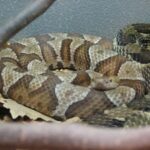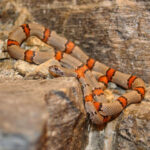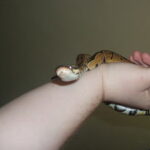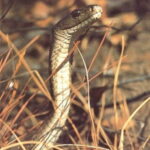Venomous snakes receive a much worse rap than they deserve. Contrary to what Hollywood would have us believe, venomous snakes are not going to hunt us down and try and kill us. Venomous snakes are actually quite particular in what they choose to strike. It takes a venomous snake about one week to replenish its supply of venom, which instinctively makes them inclined to only strike at that which they know is food. The fact of the matter is, most snakes are going to do what they can to get away from you, rather than come near you.
Still, there are hundreds of incidents every year concerning venomous snake bites. The reason for this is that most people are either not watchful of what they are doing, cannot correctly identify venomous snakes or think they are going to be a “snake wrangler” and want the thrill of handling a venomous snake.
Most snakes require a large amount of aggravation before they will actually strike at a human. Many snake bites are caused by people who have watched Jeff Corwin or Steve Irwin too many times and think that they too can handle picking up venomous snakes. And while it’s not like you need a degree to be able to handle these snakes, it does require a certain finesse. And a lot of common sense.
The other portion of snake bites that occur are generally purely accidental. You might be out hiking and not watching where you are going, and step on a snake. Or reach into some tall grass and not see the snake resting there. The snake merely feels threatened and strikes. Snakes do not contain venom specifically to kill humans. Snakes that are venomous have evolved over the years to have venom so that can quickly and efficiently kill their prey. They do not however, view humans as prey and do not strike to kill them as a source of food. They strike because they feel threatened and are just trying to survive. Human beings do the exact same thing when they feel threatened, only in different ways.
Identifying Venomous Snakes
Being able to correctly identify venomous snakes greatly reduces the chances of being bitten. Knowing where these venomous snakes live also helps to reduce the chance of being bit. Using just a little bit of caution when in areas where snakes live can prevent snake bites from occurring. Each of the following snake names given contains a link to a picture representing that specific snake.
There are three types of venomous snakes that live in North America. The Agkistrodon are the Cottonmouths and Copperheads. The Crotalus are the various species of Rattlesnakes and the Micrurus consists of Coral snakes.
Micrurus, or Coral snakes belong to the Elapidae family. In North America there are three species of Elapidae. The Western Coral Snake, Eastern Coral Snake and Yellow Belly Sea Snake. These snakes do contain stronger venom than other venomous snakes, so being able to correctly identify them is definitely a good idea. Coral snake venom is a neurotoxin, which means that the venom attacks your central nervous system.
The Agkistrodons consist of the Copperhead and the Water Moccasin, more commonly known as the Cottonmouth. These are members of the Viperidae family. These snakes live in various areas throughout the country, however there is a high population of them in the southern states. These snakes have a tendency to be viewed as extremely aggressive, however the aggression they show is merely their way of warning you away from them. Bites from these snakes usually stem from people who did not respect the fact that the snake was trying to warn them away. Water Moccasin and Copperhead venom is a hemotoxin. A hemotoxin works by destroying blood and tissue.
The Crotalus consists of the many species of rattlesnakes. Rattlesnakes are also a part of the Viperidae family. This group has the largest number of species in the United States. There are approximately 28 different species of rattlesnakes in North America. The most well known of these are the Eastern Diamondback rattlesnake, Western Diamondback rattlesnake, Timber rattlesnake, Pigmy rattlesnake and the Mohave rattlesnake. There are of course many other species of rattlesnakes spread out across North America.
Rattlesnakes are known for the distinct rattle sound that they make when they are threatened. Contrary to popular belief, most species of rattlesnakes are not nearly as aggressive as people would have you believe. It takes quite a bit of aggravation to cause a rattlesnake to actually strike at you. Rattlesnake venom is also a hemotoxin, that contains enzymes that destroys blood and tissue.
It is important to note that there are many non-venomous snakes that strongly resemble venomous snakes. These non-venomous snakes have evolved to look like their venomous relatives as a means of camouflage to make predators believe that they are venomous. A few examples of these would be the Scarlet Kingsnake which strongly resembles a Coral Snake and the Southern Water Snake which looks remarkably like a Water Moccasin. Though they look just like their venomous relatives, neither the Scarlet Kingsnake nor the Southern Water Snake are remotely venomous.
It can be quite difficult for the average person to tell the difference between these snakes. The best advice regarding these snakes, is to not take any chances. Since it can be extremely hard to tell the difference between these snakes, you should simply avoid them and not try to handle them.
Dealing With Snake Bites
It seems to be inevitable that venomous snake bites are going to occur. There are many different tips and myths floating around out there about how to handle a snake bite. There are however, two simple, hard fast rules that should always be followed if bitten by a snake.
1. Do not panic. While a snake bite can be traumatic, it is vital that you remain as calm as possible. When you panic, your heart rate increases, causing your blood to pump faster. This spreads the venom through your body at a faster rate and can cause the effects of the snake bite to work more quickly.
2. Seek immediate medical attention. Do not try and treat the snake bite yourself. Sucking the poison out does not work, nor does cutting around the bite. The best way to treat a snake bite is to immediately seek medical attention, so that you can start receiving the necessary anti-venin as soon as possible. There will of course, be damage that occurs due to a snake bite. However the sooner medical treatment is sought, the lesser the damage that my be caused.
Simply put, the best way to avoid a snake bite is to live and let live. Just leave the snake alone and walk away!
Venomous snakes are not the enemies that they are portrayed to be. When it comes to venomous snakes, a little bit of common sense can go a long way. For more in depth information on venomous and non-venomous snakes you can visit websites such as www.pit.edu or www.venomousreptiles.org. These sites offer a good amount of snake information as well as pictures of many species of snakes.






